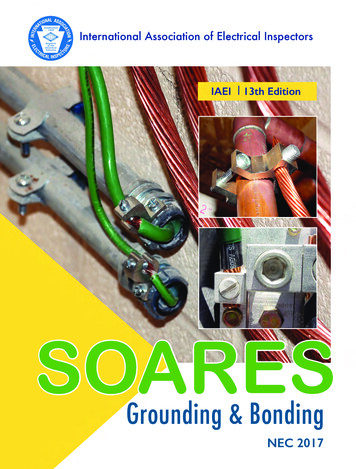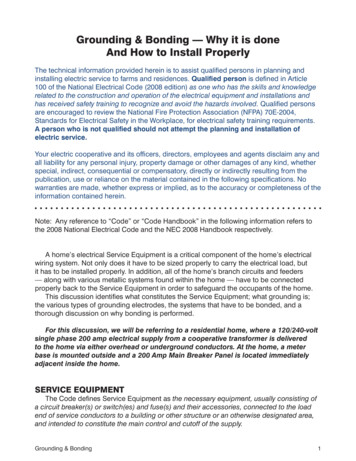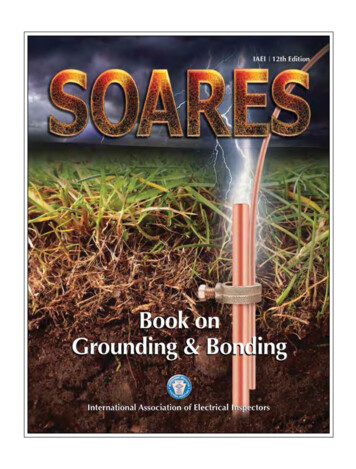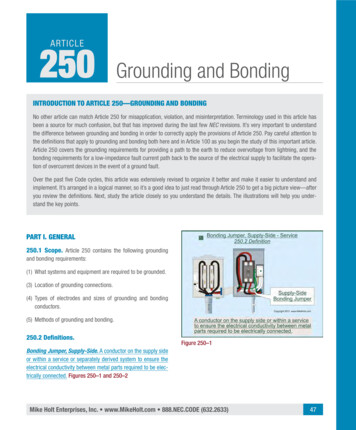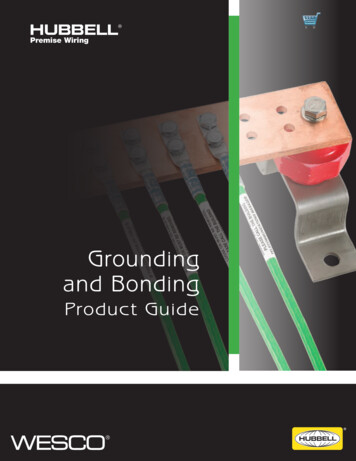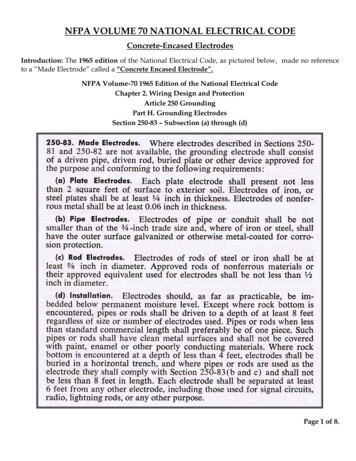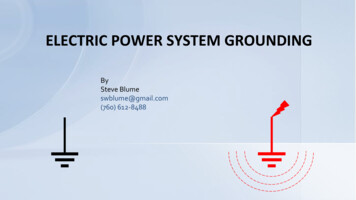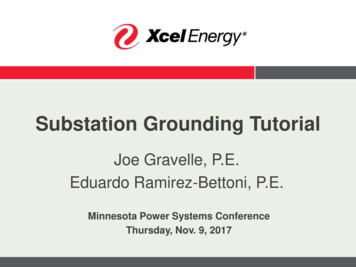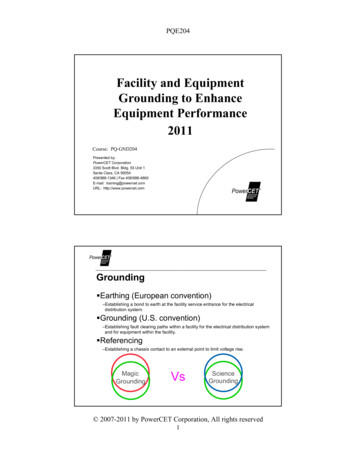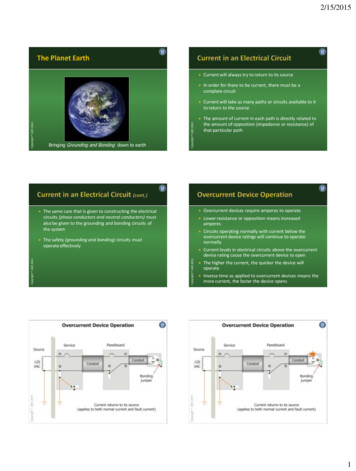
Transcription
2/15/2015 Current will always try to return to its source In order for there to be current, there must be acomplete circuit Current will take as many paths or circuits available to itto return to the source The amount of current in each path is directly related tothe amount of opposition (impedance or resistance) ofthat particular path Overcurrent devices require amperes to operate Lower resistance or opposition means increasedamperes Circuits operating normally with current below theovercurrent device ratings will continue to operatenormally Current levels in electrical circuits above the overcurrentdevice rating cause the overcurrent device to open The higher the current, the quicker the device willoperate Inverse time as applied to overcurrent devices means themore current, the faster the device opensBringing Grounding and Bonding down to earth The same care that is given to constructing the electricalcircuits (phase conductors and neutral conductors) mustalso be given to the grounding and bonding circuits ofthe systemThe safety (grounding and bonding) circuits mustoperate effectively1
2/15/2015 Grounded conductors (usually neutrals) are intended tocarry return currents from circuits to the source innormal operationThe conductor is referred to as grounded because this isthe action required at the service or separately derivedsystemThe term grounded is a past tense term meaning theaction has already happenedIt is generally not permitted to use the groundedconductor (neutral) for grounding or in makinggrounding connections on the load side of the service orseparately derived system [see 250.4(A)(5)]The goal is to keep current on the path intended for it Ground: The earth. Grounded (Grounding): Connected (connecting) toground or to a conductive body that extends theground connection. Bonded (Bonding): Connected to establish electricalcontinuity and conductivity. Grounding is a present tense wordGrounding indicates a process that is ongoingGrounding is an action required at enclosures andequipment in electrical circuits from the source orservice to the final outlet(s) on the circuitIt is accomplished by using an equipment groundingconductor of any type specified in 250.118The equipment grounding conductor of a circuit servesto put all metal enclosures at earth potential along thecircuitIt also serves as the low-impedance path (safety circuit)to carry ground-fault current to the source to facilitatethe operation of overcurrent devices in ground-faultconditionsChapter nine covers equipment grounding conductors2
2/15/2015 Grounding (Connecting to earth) Limit the voltages due to lightning, line surges orunintentional contact with higher voltage lines Stabilize voltage to ground during normal operation Bonding (Connecting together) Bonding shall be provided where necessary to ensureelectrical continuity Must have the capacity to conduct safely any faultcurrent likely to be imposed Grounding and bonding must be effective These are the safety circuits of the electrical system The safety circuit (bonding) path must have thefollowing characteristics for effectiveness anticipatedby the NEC Electrically continuous path Have adequate capacity for fault currents imposed Have lowest possible impedance See definitions in Article 2503
2/15/20154
2/15/2015 Ground: The earth. Grounded (Grounding): Connected (connecting) toground or to a conductive body that extends theground connection. Grounded Conductor: A system or circuit conductorthat is intentionally grounded.5
2/15/20156
2/15/2015 Grounded Conductor. A system or circuit conductorthat is intentionally grounded. Service. The conductors and equipment fordelivering electric energy from the serving utility tothe wiring system of the premises served.Multi-section service equipment assembly250.24(C) Exception7
2/15/2015 Where the service-entrance conductors are run inparallel, the size of the grounded conductor shall bebased on the total cm area of the parallel conductorsin the same enclosure Where the service-entrance conductors are installedin two or more raceways, the size of the groundedconductor shall be based on the size of theungrounded service-entrance conductor in theraceway but not smaller than 1/0 See 250.24(C)(2) Systems in which a grounding impedance (usually aresistor) limits the ground-fault current to a lowvalue Permitted for 3-phase ac systems of 480 volts to1000 volts8
2/15/2015 Provides uninterrupted electrical power forindustrial plants, data centers, and other continuousoperations Three conditions must be met to qualify:1. Qualified persons must be available to servicethe system2. Ground detectors must be installed to indicatean insulation failure 3. Line to neutral loads are not servedSee 250.36 Bonded (Bonding): “Connected to establishelectrical continuity and conductivity” Bonding Jumper, Main: “The connection betweenthe grounded circuit conductor and the equipmentgrounding conductor at the service” Bonding Jumper, Supply-Side: “A conductor installedon the supply side of a service or within a serviceequipment enclosure(s), or for a separately derivedsystem, that ensures the required electricalconductivity between metal parts required to beelectrically connected” [250.2]9
2/15/2015Main Bonding Jumper10
2/15/2015 Line side of service and main bonding jumper Size per Table 250.102(C)(1) Based on size of ungrounded service-entranceconductor(s) Use rules in 250.102(C) Parallel conductors in the same raceway orenclosure [see 250.102(C)(1)] Parallel conductors in separate raceways orenclosures [see 250.102(C)(2)]11
2/15/2015 Special rules are provided for bonding enclosures onthe line side of the service disconnecting means This equipment does not have overcurrentprotection on the line side (like feeders and branchcircuits) All metallic enclosures that contain serviceconductors must be bonded togetherCourtesy of Thomas and Betts Bonding ensures that none of the equipmentenclosures can become electrically isolated andbecome a shock hazard should a line-to-ground faultoccur in that enclosure Bonding also provides a low-impedance path for faultcurrent so the fuse or circuit breaker on the supplyside of the electric utility transformer will open oroperate See 250.92(A)(1) and (A)(2)250.92(A)250.92(A) The normally non-current-carrying metal parts ofequipment required to be effectively bondedtogether include:(1) The service raceways, cable trays, cablebusframework, auxiliary gutters, or service cablearmor or sheath that enclose, contain, orsupport service conductors, except as permittedin 250.80(2) All enclosures containing service conductors,including meter fittings, boxes or the like,interposed in the service raceway or armor250.92(A)12
2/15/2015Bonding Locknut Suitable for Service BondingCourtesy of Thomas and BettsBonding Wedge Suitable for Service BondingCourtesy of Thomas and Betts13
2/15/2015 Courtesy of Thomas and Betts Listed lugs, pressure connectors, other listed means(250.8)Threaded couplings and connectors or threaded hubs onenclosures where made up wrenchtightThreadless couplings and connectors if made up tight formetal raceways or metal-clad cablesOther listed devices, such as bonding-type locknuts,bushings, or bushings with bonding jumpersStandard locknuts are not permitted for the bondingrequired by this sectionBonding jumpers are required to be used aroundimpaired concentric or eccentric knockoutsConnections cannot depend on solder [250.148(E)]14
2/15/2015 Section 250.52(A) includes the details and descriptions ofgrounding electrodes that are required to be used for thegrounding electrical systems (where )(A)(8)Metal underground water pipeMetal frame of a building or structureConcrete-encased electrodeGround ringRod and pipe electrodeOther listed electrodesPlate electrodesOther local metal underground systems or structures15
2/15/2015 Section 250.52(A)(1) requires metal undergroundwater piping systems to be used for the groundingelectrical systems (where present) Must be in direct contact with the earth for 3.0 m(10 ft) or more and electrically continuous Includes any metal well casing bonded to the pipe Can be made electrically continuous by bondingaround insulating joints or insulating pipe Section 250.52(A)(2) requires the metal frame of abuilding or structure to be used for the groundingelectrical systems (where present and qualifies) Must be connected to the earth by one or more of thefollowing methods: At least one structural metal member that is in directcontact with the earth for 3.0 m (10 ft) or more (withor without concrete encasement) Hold-down bolts securing the structural steel columnthat are connected to a concrete-encased electrodethat complies with 250.52(A)(3) (located in the supportfooting or foundation) Section 250.52(A)(3) requires concrete-encased electrode is toconsist of: At least 6.0 m (20 ft) of bare copper conductor not smaller than4 AWG or one or more bare or electrically conductive coatedsteel reinforcing bars or rods of not less than 13 mm (½ in.) indiameter Installed in one continuous 6.0 m (20 ft) length, or multiplepieces connected together by the usual steel tie wires,exothermic welding, welding, etc. to create a 6.0 m (20 ft) orgreater length Metallic components to be encased by at least 50 mm (2 in.) ofconcrete Located horizontally within that portion of a concrete foundationor footing in direct contact with the earth or within verticalstructural components in direct contact with the earth16
2/15/2015Concrete-Encased Electrode17
2/15/20152/15/2015250.52(A)(6) Other Listed ElectrodesOther listed grounding electrodesshall be permitted to be used suchas a chemical ground electrodesystem Where the grounding electrodes described in250.52(A) are not present, a grounding electrodemust be installed Where none of these grounding electrodes exist,one or more of the grounding electrodes specified in250.52(A)(4) through (A)(8) shall be installed andused These “made” electrodes can consist of rod, pipe,and plate electrodes, or other listed electrodes, orlocal metal underground systems or structures See 250.50 and 250.52(A)(4) through (A)(8)Required to be listed as groundingand bonding equipment [UL 467]2/15/2015Courtesy ofERICO InternationalAn underground metal water pipe electrode isrequired to be supplemented by an additionalgrounding electrode Any of the electrodes described in 250.52(A)(2)through (A)(8) are permitted to be used (not limitedto just a ground rod) If the supplemental electrodes are of the rod, pipe,or plate types, these must be supplemented as wellor must meet the 25 ohm rule at 250.53(A)(2),Exception See 250.53(D)(2) 18
2/15/201519
2/15/2015(Based on information provided bythe IBI crew in 2014)Loose connections, loose fittings,missing screws, stripped screws,bonding bushing screws loose ormissing, bonding bushing lugsmissing, re-bar covered withoutinspection, etc.Neutral splice lugs not stacked on acommon bolt in CT or wireway.NEC Art. 200.2 (B)NEC Art. 110.3 – 14, 300.10-13Ungrounded systeminstalled/upgraded with no grounddetectors.Grounding electrode conductor notterminated TO the neutral. NECArt. 250.24NEC Art. 250.21(B)(C)20
2/15/2015Generator neutral installed with nogrounding electrode conductor(neutral lifted on transfer).Ground rod cut off.NEC Art. 250.52(A)(5)NEC Art. 250.35(A)Water meter not jumpered.NEC 250.53(D)(1)Ground rod not driven flush with orbelow grade (or otherwiseprotected).NEC Art. 250.53(G)Grounding electrode conductorspliced with split-bolt.NEC 250.64(C)Numerous errors on multidisconnect services. There is ageneral non-understanding thatNEC Art. 250.64(D)(1) – (3) isprescriptive.21
2/15/2015Improper use and application ofTables 250.66 and 250.122.Isolated Service mast not bonded.NEC Art. 250.80Intersystem Bonding missing orimproperly installed.NEC Art. 250.94Improper termination(s) ofgrounding electrode conductors.NEC Art. 250.70Improper bonding of serviceequipment, raceways, nipples,cabinets, enclosures and fittings.NEC Art. 250.92Bonding missing at concentricK.O.s for 277V, 480V installations.NEC Art. 250.9722
2/15/2015Improperly sized single daisy chainconductors.For Service – see NEC Art.250.102(C)(1) (see last sentence of250.102(C)(2)),8AWG (and smaller) re-identifiedconductors used for equipmentgrounding conductors.NEC Art. 250.119For Feeder – see NEC 250.102(D)Neutral bonded in sub-panel.NEC Art. 250.142(B)Grounds not spliced, device nottailed, and other ground continuityissues in device boxes.NEC Art. 250.148SW DIVISION IAEIGrounding DefectsCommonly FoundDuring Inspection(Based on information providedby the IBI crew of 2014)23
2/15/2015 1 Bringing Grounding and Bonding down to earth Current will always try to return to its source In order for there to be current, there must be a complete circuit Current will take as many paths or circuits available to it to return to the source The amount of current in each path is directly related to the amount of opposition (impedance or resistance) ofFile Size: 2MB
